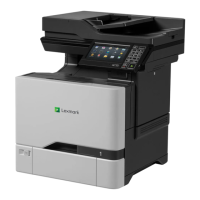Preface
This manual contains maintenance procedures for service personnel.
It is divided into the following chapters:
• General information provides a general description of the printer, tools, and equipment needed to service
the printer.
• Diagnostic information contains diagnostic aids such as error code tables, symptoms, and service checks
that you can use to isolate failing field replaceable units (FRUs).
• Service menus describes the printer interface, user, and service menus.
• Repair information provides instructions for making printer adjustments and for removing and installing
FRUs.
• Component locations illustrates the basic and fully
configured
models and
identifies
the locations of the
basic printer parts.
• Maintenance contains the specifications for lubricating the printer and recommendations to prevent printer
problems.
• Parts catalog shows illustrations and part numbers for the FRUs.
• Appendix A: Printer specifications contains detailed specifications of the product.
• Appendix B: Options and features contains the available options and other features of the product.
• Appendix C: Theory of operation contains the theory on how the printer operates.
• Appendix D: Acronyms contains a list of acronyms in the manual and their meanings.
Conventions
Note: A note identifies information that could help you.
Warning—Potential Damage: A warning
identifies
something that could damage the product hardware or
software.
A caution indicates a potentially hazardous situation that could injure you.
Dierent
types of caution statements
include:
CAUTION—POTENTIAL INJURY: Indicates a risk of injury.
CAUTION—SHOCK HAZARD: Indicates a risk of electrical shock.
CAUTION—HOT SURFACE: Indicates a risk of burn if touched.
CAUTION—TIPPING HAZARD: Indicates a crush hazard.
General caution statements
CAUTION—POTENTIAL INJURY: To avoid the risk of fire or electrical shock, connect the power cord to
an appropriately rated and properly grounded electrical outlet that is near the product and easily
accessible.
7528
Preface
23

